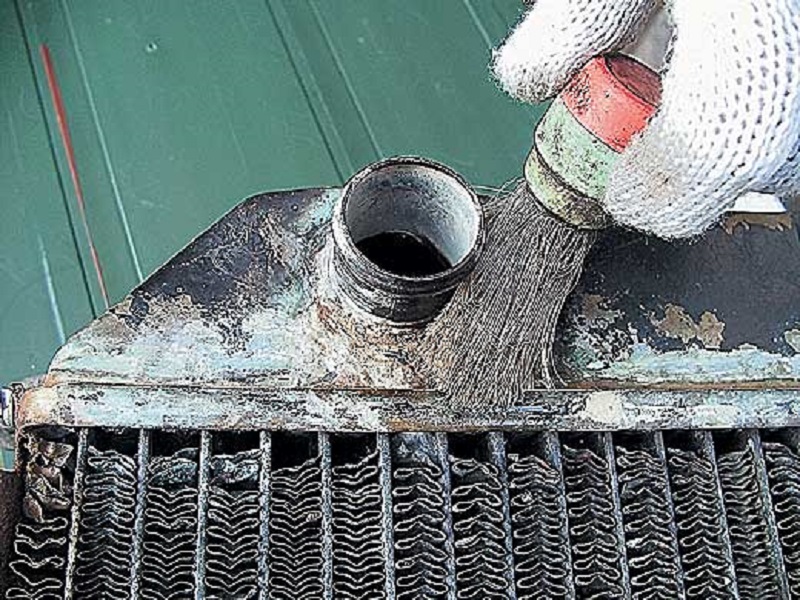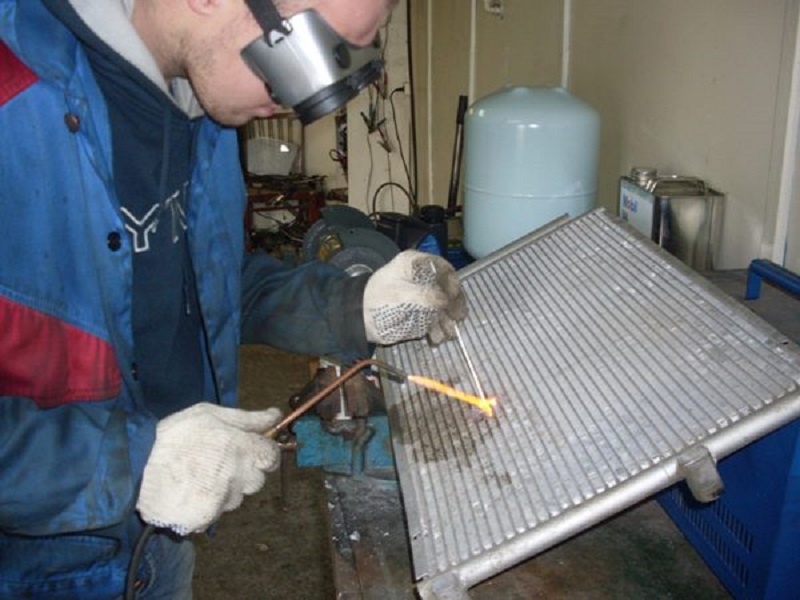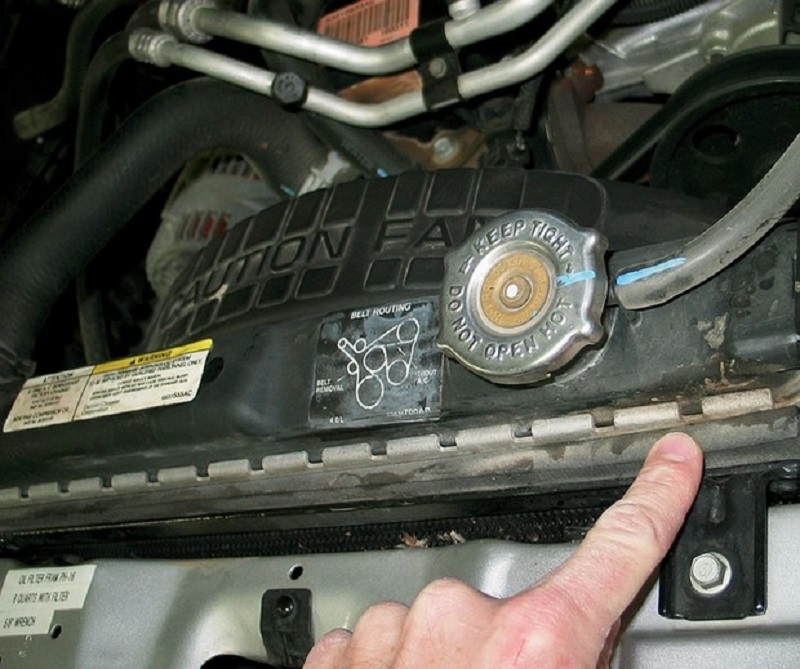The radiator is the main aggregate of the cooling system of the car. It is playing the main role in the operation of the engine and controls the stability of its temperature. Of course, the operating period of the radiator is not eternal, but it can be significantly increased even in the event of a crack. About this further in the article.
Content
- Car cooling radiator, device and purpose
- Causes of radiator breakdown
- Than rinse the radiator
- How to detect the refrigeration leakage (detail)
- Diagnostics of the radiator with their own hands (thermostat check)
- Tools, fixtures, consumables for repair of brass radiator
- How to eliminate leak brass radiator with your own hands (step by step)
- How to stick to leak aluminum car radiator
- Sealants and adhesives for car radiators
- Tips Prof.
Car cooling radiator, device and purpose
The engine cooling system consists of several components that during operation can suddenly fail. These elements include: water pump (pump), thermostat, fan and cooling radiator. It is worth noting that one of the most serious and frequent problems is the blockage of the radiator channels, as well as its leaks. Such breakdowns entail the fact that the cooling system loses the ability to efficiently maintain the engine operating temperature at the specified framework.
As a result, the need to regularly control the level of antifreeze and, if there are small leaks, constantly adding the coolant, follow the engine temperature, and so on. If the leaks through the radiator are more significant, then the movement on the car is extremely undesirable, because the risk of overheating of the engine is increasing, which is accompanied by quite serious consequences for the engine.
The car radiator, as a rule, consists of the following elements: core, lower and top tanks, fasteners. The radiator is needed that the liquid that enters it directly from the water shirt of the motor cooled to the desired temperature. The tanks of the radiator and solder the core is often made from brass, due to which good thermal conductivity is ensured.
Causes of radiator breakdown
The reasons why the cooling system does not function properly or drip the radiator, there are several. Most often, the radiator flows due to the natural wear or mechanical damage, since on many cars this component is open as much as possible to effectively blow the oncoming air flow. As a result, it is damaged by flying stones and so on.
Also, problems may appear due to the fact that the car owner did not pay attention to the maintenance and general state of the engine cooling system. In such a situation, the radiator can not rarely occur. When the radiator tubes are clogged, the liquid circulates much worse. As a result, the lower part of the heat exchanger begins to cool, and then the radiator cools completely over the entire area. At the same time, the coolant is very heated, the heat sink deteriorates, the thermoscience of the system components is significantly increased, as well as the risk of engine overheating.
It is worth noting that this problem is often eliminated by washing the radiator from the inside. As a rule, the radiator is clogged due to the accumulation in the scale system. Typically, it occurs from drivers using flow water in the cooling system, for a long time non-changing antifreeze mixing different coats and so on. Also, the blockage of the radiator leads malfunctions of the unit, due to which the exhaust gases and motor oil in antifreeze are observed.
Than rinse the radiator
There are several funds that can be washed car radiator: a solution of caustic soda, electrolyte, dairy serum, water, citric acid, coca-cola or pepsy.
Among the drivers there is an opinion that dairy serum can qualitatively remove deposits in the cooling system. It is poured instead of coolant, after which it is necessary to drive a certain distance (several tens of kilometers). Then the serum merges, and the radiator is washed with clean water. The purification procedure is performed due to lactic acid, which is sufficiently safe for the materials of the system.
Instead of the dairy serum, you can pour Coca-Cola or Pepsi. Next, you need to start the engine and give it to work for 15 minutes. If necessary, the procedure is repeated.
Some are recommended to rinse the radiator with a solution of caustic soda. But the caustic natra not only removes the flare, it is able to destroy the metal. Therefore, it is not desirable to apply it to clean the radiator.
Another means is citric acid. It is necessary to approximately 50-100 grams of the substance on the water bucket.
There are also drivers that use the electrolyte from the battery. The sulfuric acid itself is very aggressive, but it all depends on the concentration. It is better not to apply electrolyte for such purposes. Especially given the material from which nozzles are made.
The easiest way to wash the radiator is the use of water.
How to detect the refrigeration leakage (detail)
Many cars on the dashboard have a number indicator and coolant temperature. If it burns, most likely, the cooling system lacks antifreeze or there is another problem. But there are other methods for determining the leakage of coolant.
In the morning, after your car is just overnight, look under it, in order to see the presence of some kind of fluid on the ground in the hood area. If you see under the hood puddle, you need to dip your finger and sniff - so you can determine whether fuel is or something else. If this liquid is blue, red, green, red or orange, and it does not smell, you need to take a flashlight and inspect all the cutting space of the car, which is located above the puddle to find a leak - most likely, you will quickly find a wet or wet place. Also check the hoses that lead to the reservoir for cleaning the coolant and the radiator.
We check the radiator itself: feel the bottom of the radiator - so we will immediately see if it proceeds. In addition, see whether there is a radiator of reddish or whiten spots. They testify to old leaks, which probably already dried and dried, however, one way or another can easily break through again. As a rule, in a hot radiator, water evaporates very quickly. You should also check the front of the radiator for pollution of grass, mud, insects, leaves and other garbage. The decorative grille must also be checked for contamination.
There are still a number of features that allow you to determine the leakage of the coolant:
- From under the hood noticeable white smoke.
- From the heater in the cabin instead of cold air goes hot.
- From the muffler during the operation of the motor comes out a white couple.

- An antifreeze leak may also testify engine overheating.
Diagnostics of the radiator with their own hands (thermostat check)
If the thermostat failures, the coolant can pass exclusively on a small or large circle. The result of such a failure becomes the impossibility of heating the engine to operating temperature or the motor will constantly overheat. To check the thermostat, take the radiator with your hand. If the top nozzle is hot, and the lower is cold, then the thermostat is most likely sworn. In this case, replace it.
Tools, fixtures, consumables for repair of brass radiator
- Soldering iron (you can use an electric soldering iron with a power of at least 500 W).
- Soldering acid - zinc chloride.
- Special flux, bur.
- Solder, sandpaper, brush with a bristle made of metal.

How to eliminate leak brass radiator with your own hands (step by step)
Order of work:
- Remove the radiator and clean it from contamination.

- Examine it and brushed to clean the damaged areas.
- Then, using sandpaper, perform grinding. A well ground plot has a homogeneous metal glitter. Such grinding removes extra oxides and provides the desired grip of the solder with the surface.
- Next, the specified surface is applied acid, boring, flux.
- Heat the soldering iron.

- With the help of a hot soldering iron, install the solder, distributing the material on the damaged area.
It is worth noting that this method is suitable if the defective area is located far enough from the factory seams of the brass radiator. If you work with a heated soldering iron near the factory seam, it can melt and flush, since the brass is characterized by high thermal conductivity. Therefore, if the breakdown or crack is located near the seam, it is better to use other ways to repair.
How to stick to leak aluminum car radiator
It is worth noting that most radiators on modern cars are made of aluminum alloys. Because of this, the repair of an aluminum radiator with a soldering or welding is very difficult to implement at home. Considering the foregoing, the use of the sealant or different types of glue is optimal, that is, "liquid welding".
Preparation of damaged sites and pre-cleaning on aluminum products is similar to the procedure for the preparation of a brass radiator. Flashing is performed, dirt removed from the cell, then the damaged areas are cleaned with a brush and sandpaper. As for the selection of glue or sealant, a number of features should be taken into account.
For climbing breaks and cracks, "cold welding" will suit no more than 10 mm. This welding is two bars, which is practically a catalyst and adhesive basis. The principle of operation is similar to polyester or epoxy glue.
Cold welding preparation is based on mixing components to homogeneous mass. Next, the resulting mixture is attached to the form of the cone, and its sharp part is pressed into the place of the crack or breakdown. Pressing the material gives him the opportunity to partially penetrate inside, which forms contact with both outer and inner surface. Thus, the strength of the margins is rising.
If you need to remove the crack in the base of the output \\ input tubes or the grid tubes, the epoxy glue is perfect for solving the problem or its analogues. Additionally, it is recommended to add to the ready-made glue aluminum powder, not exceeding the 1/10 ratio, in which the first number is 10% of this filler. The pricking place is cleared, degreases, and then the glue itself is applied. Also during the repair, you can wind the layers of fiberglass impregnated in glue. This will increase the strength and rigidity of the repaired area. Next, epoxy glue should dry at least 24 hours, then you can install the radiator and pour antifreeze, and also check the cooling system on the tightness.
Sealants and adhesives for car radiators
Microcracks and the most insignificant holes that most often occur in the radiator housing are quite simply eliminated by special sealants. The method of using these substances is simple: the sealant is poured into the radiator or the tank for the coolant, after which it is necessary to wait for a while. Together with the coil, the sealant will circulate along the cooling system until it happens through the hole in the radiator. When interacting with air, the sealant, which the outward outward, generates a sufficiently strong polymer film around the damaged surface, returning tightness cooling system.
Tips Prof.
We recommend to see the following video:
Related Materials
- Stove 2110, bad warm stove 2110, VAZ 2110 heating system, repairing the heating system VAZ 2110 with their own hands
- VAZ 2114 stove blows with cold air, stove 2114, bad warm stove VAZ 2114, device and repair of heating VAZ 2114 do-it-yourself, removing the stove VAZ 2114
- How to subdominize the car. How to put a jack. Types of jacks for cars.
- VAZ 2109 Fuse Block, VAZ 2109 Fuse Block Carburetor, VAZ 2109 Fuse Block Injector, Old VAZ 2109 Fuse Block, VAZ 2109 Fuse Block, VAZ Fuse Block 2109
- Car exhaust gas catalyst, faulty catalyst, pluses and cons of the catalyst, how to change the catalyst on the planeencitel
- Stove blowing cold air VAZ 2114, badly blowing the stove VAZ 2114, why badly blowing the stove VAZ 2114
- How to find out the owner of the car by the number of his car, check the car by the number of the traffic police machine, check the car by the state number of the car for free
- How to choose Used tires, Useful Tips
- Winter car road, pressure in passenger car tires in winter, good battery for the car in winter, whether to warm the car in winter
- In winter, the car is poorly started. How to make a car in winter, do you need to warm up the car in winter, useful tips
- Economy fuel consumption machines, the most economical car consumption
- Tires brands for passenger cars, labeling of car tire labeling, residual passenger car tire protector, how to pick a tire on a car brand, car tire tread pattern
- Working transmission operation, mechanical gearbox clutch work, driving with manual gearbox, useful tips
- Rear beam Peugeot 206 sedan, rear beam device Peugeot 206. Rear beam Peugeot 206 Malfunction, repair of the rear beam Peugeot 206
- Diesel fuel in winter, additive for diesel fuel in winter, how to choose the best diesel fuel
- Diesel winter does not start. How to start diesel in winter, heating diesel in winter.
- Japanese bridgestone tires, winter studded bridgestone tires, bridgestone tires brand
- Tire marking decoding for passenger cars, labeling wheels, how to choose the right tires on the disks
- Diesel engine in winter, launch of the diesel engine in winter, what oil to fill in a diesel engine in winter, useful tips
- LED backlight of the car, the backlight of the bottom of the car, the backlight of the legs in the car, the backlight in the door of the car, the backlight of the car is fine
- Recovered tires, bus tire, restored tire protector, can I use them
- Choose winter tires, which is a winter tires, which pressure in winter tires should be marked with winter tires, how to choose the right winter tires, the best winter tires 2019
- Steering rail rail, knock of steering rack, reasons for the knock and repair of the steering rack do it yourself
- Cameless car tires, a set for repair of tubeless tires, repair of the cannon-free tire do it yourself
- Russian tires, Russian tires Winter, Russian All-season tires, Voronezh AMTEL tires, Tires "Matador Omsk Tire", Kama-tires are world-class bus
- How to open a car without a key. Lost the key from the car what to do, the key from the car inside the car
- Silent tires, quiet winter tires, quiet studded bus, which tires to choose, overview tires
- Tires and safety, safety of the bus, why it is necessary to constantly monitor car tires
- Rules of safe driving of the car in the rain and slush, safe driving of the car for beginners
- Rust converter which is better for cars, rust converters to choose how to use rust transducer, professionals
- Polishing the body of the car do it yourself, how to choose a polishing paste, useful tips
- Engine durability, engine life, how to extend engine life
- Knock in the car. Knock when moving the car. What can knock in the car. How to determine the cause of the knock.
- ABS car, what is ABS car, ABS system malfunction, ABS diagnostics
- Overtaking a car when you can start overtaking a car, rules of traffic rules
- Fuel pump VAZ 2110, VAZ 2110 gas station scheme, VAZ 2110 fuel pump device, VAZ 2110 gas station repair,
- Automotive antennas for radio, automotive antenna device, car antenna do it yourself
- Front suspension Kalina, device front suspension Kalina, knock in front suspension Kalina, repair of front suspension Kalina
- Shock absorber Oil, best oil shock absorbers, pumping oil shock absorbers, how to properly pump oil shock absorber
- Clutch malfunctions, touches clutch, causes a clutch malfunction, how to eliminate























Comments